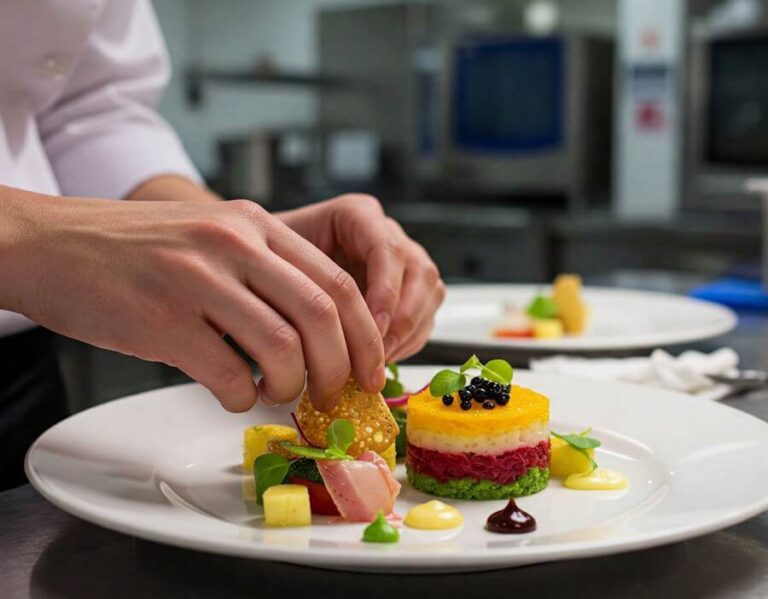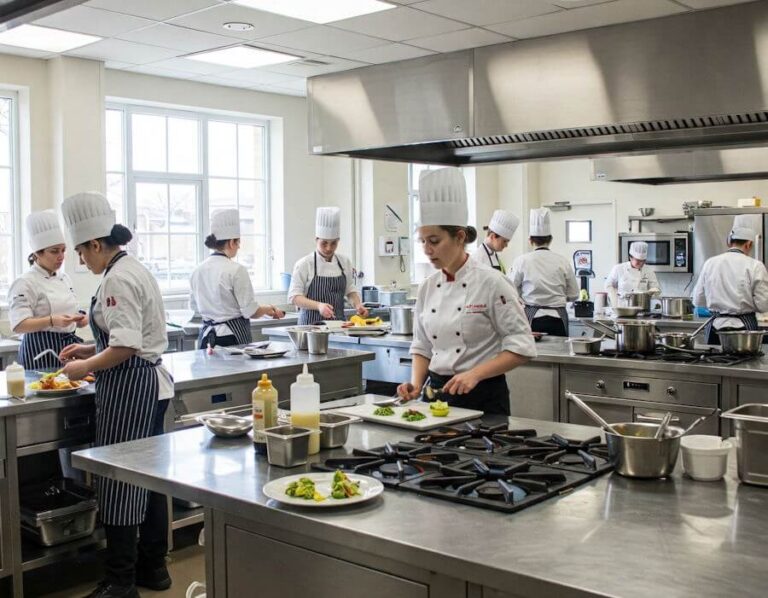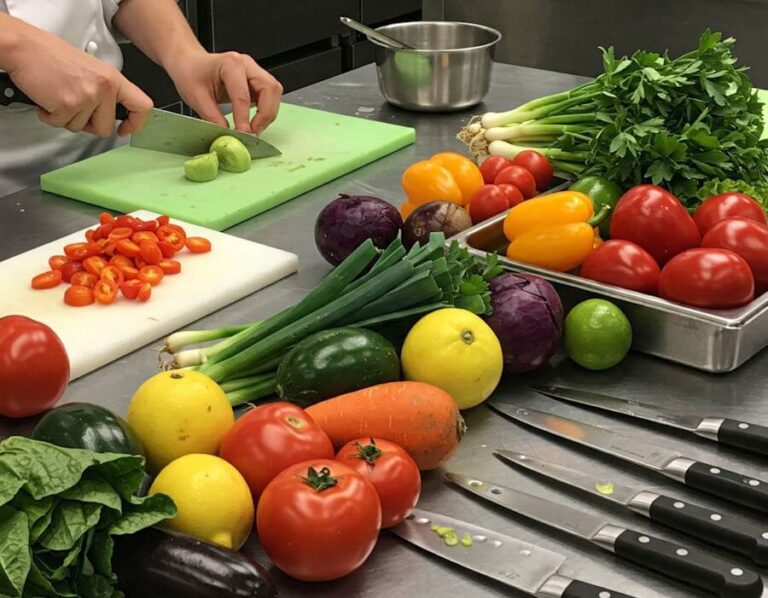Introduction to Common Cooking Mistakes
For novice culinarians, the journey into the world of cooking can be both exciting and challenging. Understanding common cooking mistakes is paramount for anyone eager to enhance their culinary skills. Beginner chefs often encounter various pitfalls that can negatively affect the quality of their dishes and diminish the overall cooking experience. Acknowledging these common errors not only fosters a deeper appreciation for the art of cooking but also promotes growth and development in kitchen proficiency.
One significant factor contributing to cooking mistakes is the lack of experience. Many novice chefs may not yet grasp the nuances of different cooking techniques, ingredient quality, and the importance of preparation. Errors such as underseasoning, overcooking, or mismanaging cooking times can lead to disappointing results that discourage budding chefs. Understanding these mistakes can empower amateur cooks to make informed decisions and improve their skills.
Furthermore, common cooking mistakes can generate frustration and confusion in the kitchen, potentially impacting one’s enjoyment of the culinary process. Cooking, ideally, should be a fulfilling endeavor that sparks creativity and joy. By addressing typical errors beginners might face, chefs can cultivate a more positive cooking environment. This sets the stage for enhancing their understanding of flavors, textures, and techniques that elevate their meals.
In this blog post, we will explore the five most frequent mistakes made by beginner chefs and offer practical advice on how to avoid them. Learning from these common pitfalls can not only improve one’s cooking but also transform the way food is prepared and enjoyed. With the right knowledge and insights, aspiring chefs can craft exceptional dishes while enjoying every moment spent in the kitchen.
Mistake 1: Not Reading the Recipe Thoroughly
One of the most common mistakes that beginner chefs make is failing to read the recipe thoroughly before commencing the cooking process. This oversight can lead to misunderstandings about the necessary steps, cooking times, or even ingredient requirements, potentially resulting in a dish that falls short of expectations. To avoid such pitfalls, a comprehensive review of the recipe is essential. It not only allows for a clear understanding of the procedures involved but also facilitates better planning and organization in the kitchen.
Preparation is a critical element in successful cooking. Before starting, it is advisable to gather all ingredients and equipment specified in the recipe. This involves measuring out ingredients and organizing them in a way that aligns with the cooking steps. By having everything ready, a beginner chef can focus on executing the recipe efficiently without the distraction of stopping to find or measure ingredients mid-cooking.
Additionally, taking the time to understand cooking terminology is vital. Many recipes may contain terms that are unfamiliar to novice cooks, such as “julienne,” “deglaze,” or “simmer.” Familiarizing oneself with these terms can prevent confusion and ensure that the recipe is followed accurately, leading to a more successful outcome. There are numerous resources available online, including glossaries and video tutorials, that can help in learning these culinary terms.
To enhance the recipe-following experience, consider taking notes or highlighting key points in the recipe. This practice can help track progress and remind the chef of any adjustments needed based on specific preferences or dietary restrictions. By adopting a systematic approach to reading and interpreting recipes, beginner chefs can improve their culinary skills and develop greater confidence in the kitchen.
Mistake 2: Ignoring Ingredient Quality
One common mistake that beginner chefs often make is overlooking the quality of the ingredients they use in their cooking. The notion that any ingredient will suffice is a misconception that can lead to subpar dishes, regardless of the cooking techniques employed. In reality, the ingredients form the foundation of any meal; therefore, their quality is paramount for achieving standout flavors and textures.
Fresh, high-quality ingredients are essential in cooking for several reasons. Firstly, they possess better taste profiles, which can significantly elevate the overall flavor of a dish. For example, ripe tomatoes bursting with flavor will always outshine their mealy, out-of-season counterparts. Similarly, high-quality meats and fish ensure that your dish is not only flavorful but also safe and nutritious. By using fresh produce and high-quality proteins, chefs can create meals that resonate well with their audience, showcasing their culinary skills effectively.
It is also important to consider the seasoning and other constituent ingredients. Spices and herbs, when fresh, can brighten up a dish and provide a complex aroma that dried or stale options cannot achieve. Therefore, investing time and effort into selecting high-quality ingredients can make a dramatic difference.
For beginner chefs looking to enhance their culinary journey, learning how to source quality ingredients is invaluable. Local farmers’ markets, organic grocery stores, or even community-supported agriculture (CSA) programs can be excellent places to find fresh, seasonal produce. Moreover, understanding the importance of ingredient sourcing not only enhances the cooking experience but also fosters a deeper connection to food and its origins. By prioritizing the quality of ingredients, novice cooks can set themselves up for success and avoid a common pitfall in their culinary endeavors.
Mistake 3: Overcrowding the Pan
One common error that beginner chefs often encounter is overcrowding the pan while cooking. This practice can lead to uneven cooking and undesirable texture in dishes. When too many ingredients are crammed into a single cooking vessel, they create an environment that hinders proper heat distribution. As a result, some pieces may remain undercooked, while others can become overcooked or burnt. This phenomenon occurs because the moisture released by the ingredients has nowhere to escape, resulting in steaming rather than the desired browning or sautéing.
The science behind cooking in batches illustrates the importance of giving each ingredient adequate space. Heat transfer, which is critical for achieving the perfect sear or roast, is significantly impaired when the pan is overcrowded. Instead of directly contacting the hot surface of the pan, food items are insulated from the heat by surrounding pieces, which slows down the cooking process. For instance, when sautéing vegetables, it’s best to work in smaller quantities. This ensures that each piece gets the necessary exposure to high heat, resulting in enhanced flavors and textures.
To avoid the pitfalls of overcrowding, consider a few practical tips. First, assess the size of your cooking equipment in relation to the quantity of food you plan to prepare. If a single pan cannot accommodate all the ingredients without crowding, cook in batches. Another useful strategy is to prepare mise en place, which involves pre-measuring and organizing ingredients prior to cooking. This practice not only streamlines the cooking process but also allows you to manage the cooking tasks more effectively, thereby preventing the impulse to overcrowd the pan. By implementing these strategies, beginner chefs can significantly improve their culinary outcomes.
Mistake 4: Skipping the Tasting Process
Tasting food during the cooking process is a crucial step that many beginner chefs often overlook. This mistake can significantly impact the overall flavor and balance of a dish. Without tasting, it becomes challenging to identify areas that require adjustment, ultimately leading to a less satisfying culinary experience. The method of integrating tasting into cooking not only enhances the flavors but also fosters a more intuitive understanding of how different ingredients interact.
To maximize the potential of your dish, it is advisable to taste at various stages throughout the cooking process. For example, tasting vegetables as they sauté can provide insight into their flavor profile and texture. Additionally, sampling a sauce midway allows the chef to assess its sweetness, acidity, and seasoning. This practice not only helps in fine-tuning flavors but also builds confidence in one’s cooking skills.
When incorporating the tasting process, it is essential to utilize a clean utensil each time to avoid contamination. Start by taking small bites that allow for a full evaluation of the dish’s flavor. Consider the balance of saltiness, sweetness, acidity, and bitterness, as these flavors should harmonize for optimal taste. If you find the dish lacking, make the necessary adjustments, whether that includes adding salt or introducing herbs for added freshness. Furthermore, understanding the concept of umami can elevate flavors, encouraging the addition of ingredients such as mushrooms or fermented sauces.
Incorporating this important tasting practice enables beginner chefs to connect with their food on a deeper level. Gaining awareness of how each ingredient contributes to the final dish enhances culinary skills and boosts confidence in the kitchen.
Mistake 5: Fearing Experimentation
One of the most common mistakes that beginner chefs encounter is the fear of experimentation in the kitchen. This anxiety often stems from a lack of confidence in their culinary skills and the desire to adhere strictly to recipes. However, embracing creativity and venturing beyond established guidelines can be a significant catalyst for growth and improvement in cooking. The essence of culinary arts lies in innovation, and it is essential for novice cooks to recognize that mastering the kitchen involves not just following recipes but also understanding and experimenting with flavors and techniques.
Experimentation opens a world of possibilities, allowing budding chefs to develop their unique style and palate. Substituting ingredients or trying new cooking methods can lead to delightful surprises and often unexpected flavor profiles. For instance, incorporating unfamiliar spices or herbs can elevate a dish and provide an avenue for personal expression. The key is to approach experimentation with a sense of curiosity rather than fear.
To build confidence in their experimentation endeavors, beginner chefs can start small. This might involve altering a single ingredient in a favorite recipe or testing a new cooking method on a familiar dish. By taking gradual steps, they can acclimatize themselves to the idea of culinary risks without feeling overwhelmed. Additionally, keeping a cooking journal can be beneficial—documenting experiments, successes, and failures can help track progress and refine techniques over time.
In summation, fostering an experimental mindset in the kitchen enriches the cooking experience and promotes personal growth. Beginner chefs should embrace the unknown, as doing so expands their culinary repertoire and ultimately enhances their confidence as they evolve into skilled home cooks.
Tips for Continuous Improvement
For beginner chefs aiming to enhance their culinary skills, continuous improvement is essential. The kitchen is a realm where practice truly makes perfect. Regular cooking allows individuals to experiment with techniques, understand ingredient interactions, and develop intuitive skills. Setting aside time each week to try new recipes or revisit favorites can foster this growth. As novice cooks familiarize themselves with various cooking methods—from baking to sautéing—they can transition from following recipes to grasping the principles behind them, which significantly boosts their confidence and creativity.
Moreover, seeking feedback is a crucial component of skill development. Whether it is from family, friends, or a cooking community online, constructive criticism can offer valuable insights. Encouraging associates to share their thoughts on flavors and presentation not only helps identify areas for improvement but also nurtures a collaborative cooking environment. Using this feedback, chefs can refine their approach to seasoning, plating, and technique, leading to better outcomes in their culinary endeavors.
Another effective strategy for continuous improvement is learning from mistakes. Every chef, regardless of their skill level, encounters challenges. Rather than viewing these mishaps as failures, they should be seen as opportunities for growth. Reflecting on what went wrong and why can illuminate lessons that enhance one’s cooking prowess. Keeping a cooking journal can be beneficial: noting down recipes, modifications, results, and observations can propel future success.
Additionally, aspiring cooks can seek resources that cater to their learning needs. Enrolling in cooking classes, either in-person or online, can provide hands-on training and expert guidance. Utilizing cookbooks—especially those that cover fundamentals or focus on specific cuisines—can also aid in widening culinary knowledge. Finally, exploring online content, such as cooking blogs, YouTube channels, or social media platforms dedicated to food, can pave the way for continuous inspiration and growth in the kitchen.
Conclusion: Embracing the Learning Journey
Cooking is an art that requires patience, practice, and a willingness to learn. It is essential to recognize that all chefs, regardless of their experience or expertise, make mistakes in the kitchen. These missteps are not indicative of failure; rather, they serve as valuable learning experiences that contribute to the growth of one’s culinary skills. For beginner chefs, understanding this can alleviate some of the pressure that often accompanies culinary exploration.
Each time a mistake is made, it presents an opportunity to reflect, adapt, and improve. Whether it’s improperly measuring ingredients or misjudging cooking times, these errors provide insights that enable chefs to fine-tune their techniques and develop a deeper understanding of flavors and cooking processes. By viewing mistakes through the lens of growth, beginner chefs can foster resilience and cultivate a more enriching cooking experience.
The journey of mastering cooking is about more than just assembling ingredients and following recipes; it is a continuous cycle of experimentation and discovery. With every dish attempted, there lies the potential for creative expression and personal development. Whenever a recipe doesn’t turn out as expected, it can spark curiosity and prompt chefs to ask essential questions: What went wrong? How can I ensure better results next time? Such inquiries are at the heart of culinary growth, nurturing both confidence and competence in the kitchen.
As beginner chefs embrace this learning journey, they should focus on the joy of cooking itself and the satisfaction that improvement brings. Celebrating small victories and acknowledging progress, no matter how incremental, can transform the cooking experience into a rewarding adventure. The path to culinary proficiency is uniquely individual, and fostering a positive mindset is crucial for long-term enjoyment and success in the kitchen.
Additional Resources for Beginner Chefs
For those embarking on their culinary journey, having access to the right resources is fundamental. Various platforms offer essential guidance, practical skills, and a wealth of inspiration. Below, we provide a curated list of resources that will assist beginner chefs in honing their craft and avoiding common pitfalls.
Cooking blogs serve as excellent starting points, providing comprehensive recipes, cooking tips, and personal anecdotes that make learning enjoyable. Websites such as Serious Eats and Cooking Light are highly regarded for their easy-to-follow recipes and culinary advice. These blogs often offer valuable insights on ingredient selection, cooking techniques, and kitchen tools that can help new cooks gain confidence.
Furthermore, visual learners may benefit significantly from YouTube channels dedicated to cooking. Prominent channels like Tasty and Bon Appétit provide engaging video content that showcases step-by-step cooking processes, enabling beginner chefs to grasp concepts easily. These channels often cover a range of cuisines and skill levels, ensuring that there is something for everyone.
Online cooking courses are another effective avenue for those seeking structured learning. Platforms like Coursera and MasterClass offer courses taught by professional chefs, covering fundamental cooking methods and advanced techniques. These courses can aid in building a solid foundation and expanding culinary techniques significantly.
Lastly, joining online communities and forums can provide ongoing support and camaraderie. Websites like Reddit’s Cooking Community and Cookpad allow beginner chefs to ask questions, share their experiences, and exchange recipes with fellow enthusiasts. Engaging with these communities facilitates a collaborative environment, helping novice cooks feel connected as they navigate their culinary adventures.
Call to Action: Share Your Cooking Experiences
As we wrap up our exploration of the common mistakes that beginner chefs often encounter, we want to extend an invitation to our readers. Cooking is a journey filled with learning opportunities, and every chef, whether novice or experienced, has their own unique stories to tell. We encourage you to share your personal cooking experiences with us. Have you encountered any of the five mistakes we discussed? Perhaps you have faced different challenges in the kitchen that taught you invaluable lessons. Your stories can serve as inspiration for others and create a supportive community where aspiring chefs can thrive.
By engaging with fellow cooking enthusiasts, you will not only enhance your culinary skills but also find camaraderie in shared experiences. In the comments section below, we invite you to recount your cooking triumphs and mishaps, offer tips that have served you well, or ask questions about your culinary dilemmas. This is an opportunity to connect with others who share a passion for cooking, regardless of their skill level. Your participation can foster a warm environment where individuals feel encouraged to learn, experiment, and ultimately improve their cooking abilities.
Furthermore, if you have developed strategies for avoiding common pitfalls in the kitchen, we would love for you to share those as well. The world of cooking is vast and varied, and no two kitchen experiences are exactly alike. By exchanging knowledge and experiences, we can collectively navigate the beautiful complexities of cooking. We look forward to reading your comments and celebrating the joys and challenges of culinary exploration together. So, let’s begin this delicious conversation—share your stories below! Your insights could be the catalyst for someone else’s cooking success.




